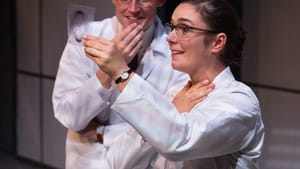Stay in the Loop
BSR publishes on a weekly schedule, with an email newsletter every Wednesday and Thursday morning. There’s no paywall, and subscribing is always free.
Science and personality
'Photograph 51' at the Lantern Theater

Photograph 51 is a smart play about very smart people. They talk smart, they dress poorly, they use big words, and their personal lives are a mess. It’s the story of the people who unlocked the “secret of life,” the structure of the DNA molecule that we now take for granted. And it’s the story of how women, even in the rarified atmosphere of pure science, can be discounted and discredited.
The start of Photograph 51 resembles the recent Vanity Fair photo of the hosts of late-night television — all male, mostly white. The play begins by revealing the scientists who discovered DNA’s structure: five men and one woman, wearing a red suit and heels, step into the light. They begin to debate the story of how things came to be, and it was not a tale of collaboration and collegiality.
We know two of the scientists: James Watson, played by Trevor William Fayle with a shock of unruly hair, and Francis Crick, played by Harry Smith with a broad Scottish accent. A third we know less well, although he shared in the Nobel Prize in 1962: Maurice Wilkins, played with lots of insecurities by Joseph McGranaghan. They are brilliant and devious and, in this show, a bit lazy, it seems, willing to borrow and build on others’ work rather than do their own research.
The name that is probably least familiar is Rosalind Franklin (Geneviève Perrier), whose crystalline x-ray photograph of the DNA molecule revealed the image of the double helix.
Dealing with the outsider
Because Franklin is a loner, a woman, and a Jew, she has a hard time fitting in. And the men have a hard time trying to figure out how to deal with her. Wilkins insults her from the start: He doesn’t call her by her title, “doctor,” can’t figure out if he should take her to lunch, is unable to collaborate with her, and ultimately betrays her. The two other peripheral characters — perpetual doctoral student Ray Gosling (Harry Watermeier) who adds levity to the proceedings, and a new PhD from America, Don Caspar (Chris Anthony), a potential romantic suitor — are her supporters, while Crick and Watson are her rivals, using Wilkins to get access to her research.
There’s something about smart people that intrigues us. Last year’s QED at the Lantern was about Richard Feynman, another smart person talking about things we don’t really understand, in that case quantum physics. That was a hit. On TV, The Big Bang Theory is about very smart scientists who could probably change the world if they could only get their own lives together. Scorpion and CSI: Cyber are about geniuses who save the world in another way while struggling to figure out how to live normal lives.
But the actors in Photograph 51 did not seem quite comfortable taking on the personae of smart people. Somehow they felt they had to act as they imagined smart people would act, but, of course, smart people are just people; they really aren’t different from the rest of us. Hang around academia long enough and you’ll see it’s not so different from a corporate environment; we just dress worse and are paid a lot less.
Why can’t a woman be more like a man?
If the intent of the play is to show how women are discriminated against in science, the show is so nuanced that it doesn’t quite come across. I left the theater wanting to blame the victim. If only Franklin had been, as her colleagues say, more — sociable, open, risk-taking, willing to go ahead without certainty of proof — you fill in the blank, but they all translate to “more feminine.” Or even more commanding. I wonder if that lack was in the writing, the acting, or the directing.
The play ends with an imagined relationship/collaboration between Wilkins and Franklin, which also gives an odd message. Even in the rarified atmosphere of pure science, do we all need a little romance?
Photograph 51 is a fascinating exploration of the behind-the-scenes machinations of a major scientific discovery played as an ensemble. Franklin’s character never quite revealed all her layers, which made her a little less compelling than she might have been. Nevertheless, the fact that a play about DNA, a topic about which I know so little, held the audience’s attention for the evening makes it worth seeing.
What, When, Where
Photograph 51. By Anna Ziegler. Kathryn MacMillan directed. Through October 11, 2015 at the Lantern Theater Company at St. Stephen’s Theater, 10th and Ludlow Streets, Philadelphia. 215-829-0395 or lanterntheater.org.
Sign up for our newsletter
All of the week's new articles, all in one place. Sign up for the free weekly BSR newsletters, and don't miss a conversation.

 Naomi Orwin
Naomi Orwin